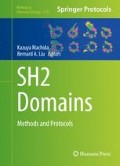Abstract
Over the last two decades there has been a significant effort in the field to characterize the phosphosite binding specificities of SH2 domains with the goal of deciphering the pY signaling code. Although high throughput studies in various formats using most SH2 domains have collectively provided a rich resource of in vitro SH2–pTyr site specificity maps, this data can only be used approximate what is happening in the cell where protein concentrations and localization are not homogenous, as they are for in vitro experiments. Here we describe an in vivo approach, SH2 site protection assay, which can capture the pTyr binding specificity of SH2 domains in the cell. The basis of this approach is SH2–pY site protection, the ability of SH2 domains to prevent the PTP-dependent dephosphorylation of their pY site binding partners. We overexpress a tracer SH2 domain in cells and quantify the change in abundance of tyrosine phosphorylated sites using MS. Since the method is performed in vivo, it has the advantage of identifying SH2–pY interactions as they occur within in the cell.
Access this chapter
Tax calculation will be finalised at checkout
Purchases are for personal use only
References
Vermeulen M, Hubner NC, Mann M (2008) High confidence determination of specific protein-protein interactions using quantitative mass spectrometry. Curr Opin Biotechnol 19:331–337. doi:10.1016/j.copbio.2008.06.001
Hino N, Oyama M, Sato A, Mukai T, Iraha F, Hayashi A, Kozuka-Hata H, Yamamoto T, Yokoyama S, Sakamoto K (2011) Genetic incorporation of a photo-crosslinkable amino acid reveals novel protein complexes with GRB2 in mammalian cells. J Mol Biol 406:343–353. doi:10.1016/j.jmb.2010.12.022
Roux KJ, Kim DI, Raida M, Burke B (2012) A promiscuous biotin ligase fusion protein identifies proximal and interacting proteins in mammalian cells. J Cell Biol 196:801–810. doi:10.1083/jcb.201112098
Daly RJ, Daum G, Lil N, Fischer EH, Burgess WH, Ullrich A, Schlessinger J (1992) SH2 domains prevent tyrosine dephosphorylation of the EGF receptor: identification of Tyr992 as the high-affinity binding site for SH2 domains of phospholipase CT. EMBO J 11:559–567
Wills MKB, Tong J, Tremblay SL, Moran MF, Jones N (2014) The ShcD signaling adaptor facilitates ligand-independent phosphorylation of the EGF receptor. Mol Biol Cell 25:739–752. doi:10.1091/mbc.E13-08-0434
Kleiman LB, Maiwald T, Conzelmann H, Lauffenburger DA, Sorger PK (2011) Rapid phospho-turnover by receptor tyrosine kinases impacts downstream signaling and drug binding. Mol Cell 43:723–737. doi:10.1016/j.molcel.2011.07.014
Sharma K, D’Souza RCJ, Tyanova S, Schaab C, Wiśniewski JR, Cox J, Mann M (2014) Ultradeep human phosphoproteome reveals a distinct regulatory nature of Tyr and Ser/Thr-based signaling. Cell Rep 8:1583–1594. doi:10.1016/j.celrep.2014.07.036
Zhang Y, Wolf-Yadlin A, Ross PL, Pappin DJ, Rush J, Lauffenburger DA, White FM (2005) Time-resolved mass spectrometry of tyrosine phosphorylation sites in the epidermal growth factor receptor signaling network reveals dynamic modules. Mol Cell Proteomics 4:1240–1250. doi:10.1074/mcp.M500089-MCP200
Jadwin JA, Oh D, Curran TG, Ogiue-Ikeda M, Jia L, White FM, Machida K, Yu J, Mayer BJ (2016) Time-resolved multimodal analysis of Src Homology 2 (SH2) domain binding in signaling by receptor tyrosine kinases. Elife 5:1–26. doi:10.7554/eLife.11835
Machida K, Thompson CM, Dierck K, Jablonowski K, Kärkkäinen S, Liu B, Zhang H, Nash PD, Newman DK, Nollau P, Pawson T, Renkema GH, Saksela K, Schiller MR, Shin D-G, Mayer BJ (2007) High-throughput phosphotyrosine profiling using SH2 domains. Mol Cell 26:899–915. doi:10.1016/j.molcel.2007.05.031
Zhang Y, Wolf-Yadlin A, White FM (2007) Quantitative proteomic analysis of phosphotyrosine-mediated cellular signaling networks. Methods Mol Biol (Clifton, NJ) 359:203–212
Vacic V, Iakoucheva LM, Radivojac P (2006) Two sample logo: a graphical representation of the differences between two sets of sequence alignments. Bioinformatics 22:1536–1537. doi:10.1093/bioinformatics/btl151
Crooks G, Hon G, Chandonia J, Brenner S (2004) WebLogo: a sequence logo generator. Genome Res 14:1188–1190. doi:10.1101/gr.849004.1
Hornbeck PV, Kornhauser JM, Tkachev S, Zhang B, Skrzypek E, Murray B, Latham V, Sullivan M (2012) PhosphoSitePlus: a comprehensive resource for investigating the structure and function of experimentally determined post-translational modifications in man and mouse. Nucleic Acids Res 40:D261–D270. doi:10.1093/nar/gkr1122
Jadwin JA, Mayer BJ, Kazuya M (2015) Detection and quantification of protein–protein interactions by far-western blotting. In: Kurien B, Scofield H (eds) Western blotting, vol 1312, Methods in molecular biology. Springer, New York, pp 379–398
Tinti M, Kiemer L, Costa S, Miller ML, Sacco F, Olsen JV, Carducci M, Paoluzi S, Langone F, Workman CT, Blom N, Machida K, Thompson CM, Schutkowski M, Brunak S, Mann M, Mayer BJ, Castagnoli L, Cesareni G (2013) The SH2 domain interaction landscape. Cell Rep 3:1293–1305. doi:10.1016/j.celrep.2013.03.001
Machida K, Mayer BJ, Nollau P (2003) Profiling the global tyrosine phosphorylation state. Mol Cell Proteomics 2:215–233. doi:10.1074/mcp.R300002-MCP200
Wolf-Yadlin A, Hautaniemi S, Lauffenburger DA, White FM (2007) Multiple reaction monitoring for robust quantitative proteomic analysis of cellular signaling networks. Proc Natl Acad Sci U S A 104:5860–5865. doi:10.1073/pnas.0608638104
Blagoev B, Ong S-E, Kratchmarova I, Mann M (2004) Temporal analysis of phosphotyrosine-dependent signaling networks by quantitative proteomics. Nat Biotechnol 22:1139–1145. doi:10.1038/nbt1005
Liu BA, Engelmann BW, Nash PD (2012) The language of SH2 domain interactions defines phosphotyrosine-mediated signal transduction. FEBS Lett 586:2597–2605. doi:10.1016/j.febslet.2012.04.054
Huang H, Li L, Wu C, Schibli D, Colwill K, Ma S, Li C, Roy P, Ho K, Songyang Z, Pawson T, Gao Y, Li SS-C (2008) Defining the specificity space of the human SRC homology 2 domain. Mol Cell Proteomics 7:768–784. doi:10.1074/mcp.M700312-MCP200
Acknowledgments
I would like to thank Timothy Curran for his work on Mass Spectrometry experiments, Kazuya Machida for assistance with editing, and Bruce Mayer for assistance with concept development. This study was partly supported by grant CA1154966 from the National Institutes of Health.
Author information
Authors and Affiliations
Corresponding author
Editor information
Editors and Affiliations
Rights and permissions
Copyright information
© 2017 Springer Science+Business Media LLC
About this protocol
Cite this protocol
Jadwin, J.A. (2017). SH2 Binding Site Protection Assay: A Method for Identification of SH2 Domain Interaction Partners by Exploiting SH2 Mediated Phosphosite Protection. In: Machida, K., Liu, B. (eds) SH2 Domains. Methods in Molecular Biology, vol 1555. Humana Press, New York, NY. https://doi.org/10.1007/978-1-4939-6762-9_28
Download citation
DOI: https://doi.org/10.1007/978-1-4939-6762-9_28
Published:
Publisher Name: Humana Press, New York, NY
Print ISBN: 978-1-4939-6760-5
Online ISBN: 978-1-4939-6762-9
eBook Packages: Springer Protocols

